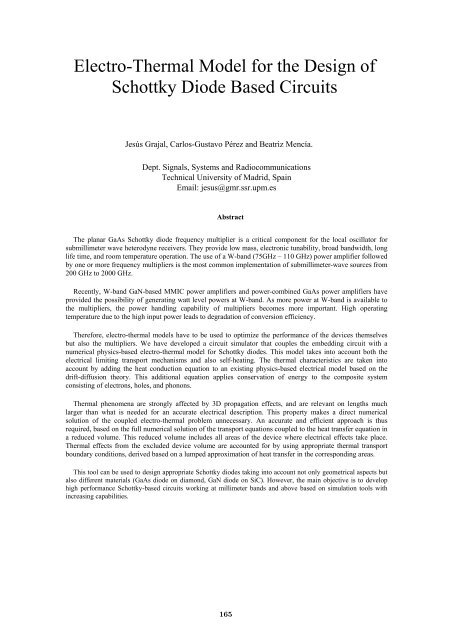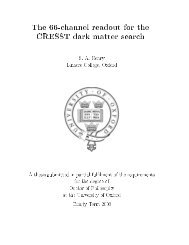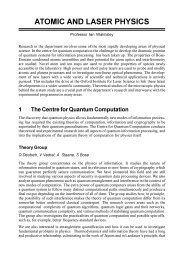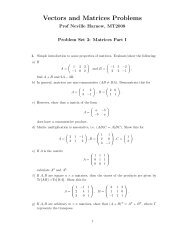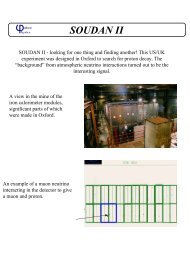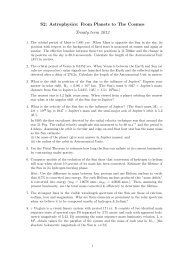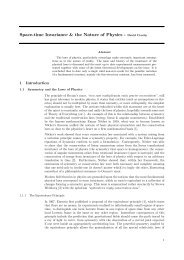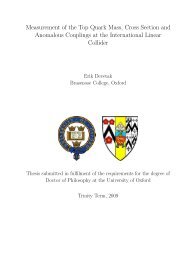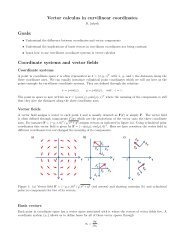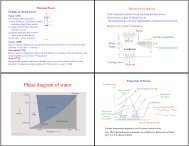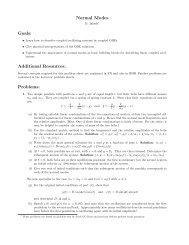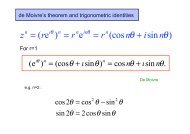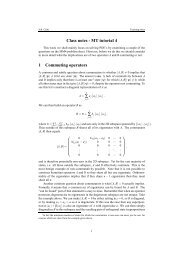Session S6: Schottky Diodes and Mixers - Department of Physics
Session S6: Schottky Diodes and Mixers - Department of Physics
Session S6: Schottky Diodes and Mixers - Department of Physics
You also want an ePaper? Increase the reach of your titles
YUMPU automatically turns print PDFs into web optimized ePapers that Google loves.
Electro-Thermal Model for the Design <strong>of</strong><br />
<strong>Schottky</strong> Diode Based Circuits<br />
Jesús Grajal, Carlos-Gustavo Pérez <strong>and</strong> Beatriz Mencía.<br />
Dept. Signals, Systems <strong>and</strong> Radiocommunications<br />
Technical University <strong>of</strong> Madrid, Spain<br />
Email: jesus@gmr.ssr.upm.es<br />
Abstract<br />
The planar GaAs <strong>Schottky</strong> diode frequency multiplier is a critical component for the local oscillator for<br />
submillimeter wave heterodyne receivers. They provide low mass, electronic tunability, broad b<strong>and</strong>width, long<br />
life time, <strong>and</strong> room temperature operation. The use <strong>of</strong> a W-b<strong>and</strong> (75GHz – 110 GHz) power amplifier followed<br />
by one or more frequency multipliers is the most common implementation <strong>of</strong> submillimeter-wave sources from<br />
200 GHz to 2000 GHz.<br />
Recently, W-b<strong>and</strong> GaN-based MMIC power amplifiers <strong>and</strong> power-combined GaAs power amplifiers have<br />
provided the possibility <strong>of</strong> generating watt level powers at W-b<strong>and</strong>. As more power at W-b<strong>and</strong> is available to<br />
the multipliers, the power h<strong>and</strong>ling capability <strong>of</strong> multipliers becomes more important. High operating<br />
temperature due to the high input power leads to degradation <strong>of</strong> conversion efficiency.<br />
Therefore, electro-thermal models have to be used to optimize the performance <strong>of</strong> the devices themselves<br />
but also the multipliers. We have developed a circuit simulator that couples the embedding circuit with a<br />
numerical physics-based electro-thermal model for <strong>Schottky</strong> diodes. This model takes into account both the<br />
electrical limiting transport mechanisms <strong>and</strong> also self-heating. The thermal characteristics are taken into<br />
account by adding the heat conduction equation to an existing physics-based electrical model based on the<br />
drift-diffusion theory. This additional equation applies conservation <strong>of</strong> energy to the composite system<br />
consisting <strong>of</strong> electrons, holes, <strong>and</strong> phonons.<br />
Thermal phenomena are strongly affected by 3D propagation effects, <strong>and</strong> are relevant on lengths much<br />
larger than what is needed for an accurate electrical description. This property makes a direct numerical<br />
solution <strong>of</strong> the coupled electro-thermal problem unnecessary. An accurate <strong>and</strong> efficient approach is thus<br />
required, based on the full numerical solution <strong>of</strong> the transport equations coupled to the heat transfer equation in<br />
a reduced volume. This reduced volume includes all areas <strong>of</strong> the device where electrical effects take place.<br />
Thermal effects from the excluded device volume are accounted for by using appropriate thermal transport<br />
boundary conditions, derived based on a lumped approximation <strong>of</strong> heat transfer in the corresponding areas.<br />
This tool can be used to design appropriate <strong>Schottky</strong> diodes taking into account not only geometrical aspects but<br />
also different materials (GaAs diode on diamond, GaN diode on SiC). However, the main objective is to develop<br />
high performance <strong>Schottky</strong>-based circuits working at millimeter b<strong>and</strong>s <strong>and</strong> above based on simulation tools with<br />
increasing capabilities.<br />
165


